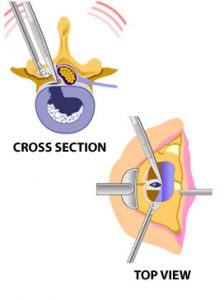Lumbar Foraminotomy Surgery
For Arm or Leg Pain Relief
A lumbar foraminotomy is a procedure performed to relieve pressure upon a nerve as it exits the spinal canal. Nerves leave the spinal canal through small openings called foramen where they can be compressed as a result of a disc protrusion, bone spur or thickened ligament. The patient will experience pain traveling down the arm or leg in the distribution of the compressed nerve root.

This surgery is generally performed to relieve arm or leg pain.
Before the operation begins, the anesthesiologist will put the patient to sleep. The patient will then be turned on to their stomach in the operating room. This is done in an extremely careful manner to protect all pressure points. After the appropriate antibiotics are given, x-ray may be used to guide the placement of the incision. The incision is performed in the midline.
The lamina or roof of the spinal canal is exposed and the surgeon then removes a small portion while visualizing it under the microscope. Either disc or bone spur is removed to decompress the spinal nerve as it leaves the neural foramen. Micro-instruments are used to make sure that the nerves are completely free. After this is done, the wound is irrigated with an antibiotic solution and closed.
Patients are generally discharged home the day of or the day following surgery. The leg pain is typically significantly improved although the patient may experience numbness in the leg, twinges of leg pain, pain around the incision and, at times, spasms of the back muscles. Medications will be given for this. This should improve within one to two weeks after surgery.
Patients should keep their back incisions dry until they are seen in the office generally seven to ten days after surgery. They should try to avoid any bending, lifting or twisting for four to six weeks after surgery. Depending upon the type of work they do for a living and how strenuous their job requirements are, they may return to work within two to four weeks with some temporary restrictions.
Risks of the surgery are generally low. Potential risks include bleeding, infection, nerve injury, spinal fluid leak and recurrence of another disc herniation at the same level.